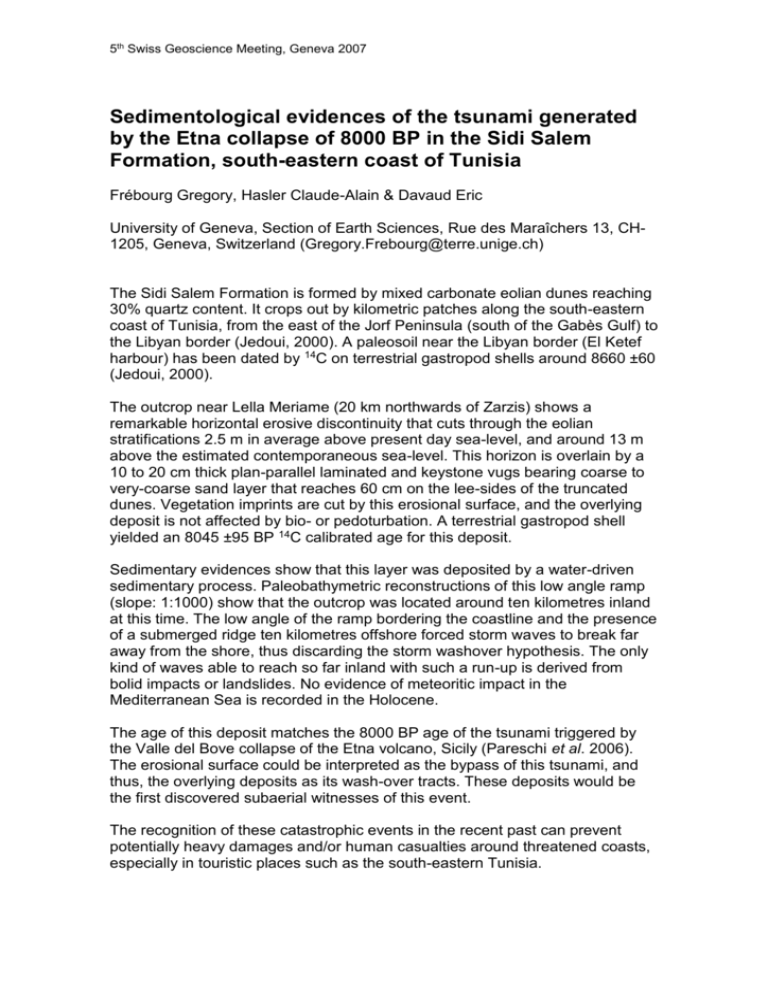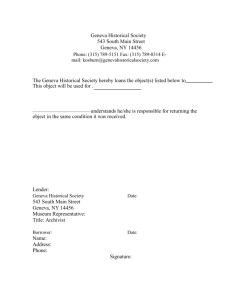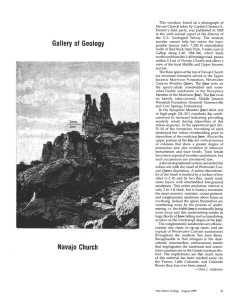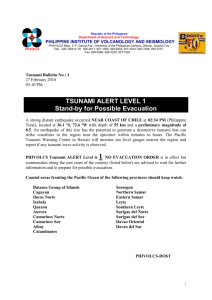Frebourg_Dominique_Poster
advertisement

5th Swiss Geoscience Meeting, Geneva 2007 Sedimentological evidences of the tsunami generated by the Etna collapse of 8000 BP in the Sidi Salem Formation, south-eastern coast of Tunisia Frébourg Gregory, Hasler Claude-Alain & Davaud Eric University of Geneva, Section of Earth Sciences, Rue des Maraîchers 13, CH1205, Geneva, Switzerland (Gregory.Frebourg@terre.unige.ch) The Sidi Salem Formation is formed by mixed carbonate eolian dunes reaching 30% quartz content. It crops out by kilometric patches along the south-eastern coast of Tunisia, from the east of the Jorf Peninsula (south of the Gabès Gulf) to the Libyan border (Jedoui, 2000). A paleosoil near the Libyan border (El Ketef harbour) has been dated by 14C on terrestrial gastropod shells around 8660 ±60 (Jedoui, 2000). The outcrop near Lella Meriame (20 km northwards of Zarzis) shows a remarkable horizontal erosive discontinuity that cuts through the eolian stratifications 2.5 m in average above present day sea-level, and around 13 m above the estimated contemporaneous sea-level. This horizon is overlain by a 10 to 20 cm thick plan-parallel laminated and keystone vugs bearing coarse to very-coarse sand layer that reaches 60 cm on the lee-sides of the truncated dunes. Vegetation imprints are cut by this erosional surface, and the overlying deposit is not affected by bio- or pedoturbation. A terrestrial gastropod shell yielded an 8045 ±95 BP 14C calibrated age for this deposit. Sedimentary evidences show that this layer was deposited by a water-driven sedimentary process. Paleobathymetric reconstructions of this low angle ramp (slope: 1:1000) show that the outcrop was located around ten kilometres inland at this time. The low angle of the ramp bordering the coastline and the presence of a submerged ridge ten kilometres offshore forced storm waves to break far away from the shore, thus discarding the storm washover hypothesis. The only kind of waves able to reach so far inland with such a run-up is derived from bolid impacts or landslides. No evidence of meteoritic impact in the Mediterranean Sea is recorded in the Holocene. The age of this deposit matches the 8000 BP age of the tsunami triggered by the Valle del Bove collapse of the Etna volcano, Sicily (Pareschi et al. 2006). The erosional surface could be interpreted as the bypass of this tsunami, and thus, the overlying deposits as its wash-over tracts. These deposits would be the first discovered subaerial witnesses of this event. The recognition of these catastrophic events in the recent past can prevent potentially heavy damages and/or human casualties around threatened coasts, especially in touristic places such as the south-eastern Tunisia. 5th Swiss Geoscience Meeting, Geneva 2007 Fig. 1: Tsunamite layer cutting through the eolian dunes of the Sidi Salem Formation at Lella Meriame. Plain oblique lines underline the eolian foresets, dashed line shows the erosional surface, and the dotted line shows the normal stratigraphic contact with the overlying lithified dunes. REFERENCES Jedoui, Y. 2000 : Sédimentologie et geochronologie des dépôts littoraux quaternaires : reconstitution des variations des paléoclimats et du niveau marin dans le Sud-est tunisien. PhD Thesis, University of Tunis II, 338 pp. Pareschi, M.T., Boschi, E. and Favalli, M. 2006: Lost tsunami. Geophysical Research Letters, 33, L22608, 1-6.












